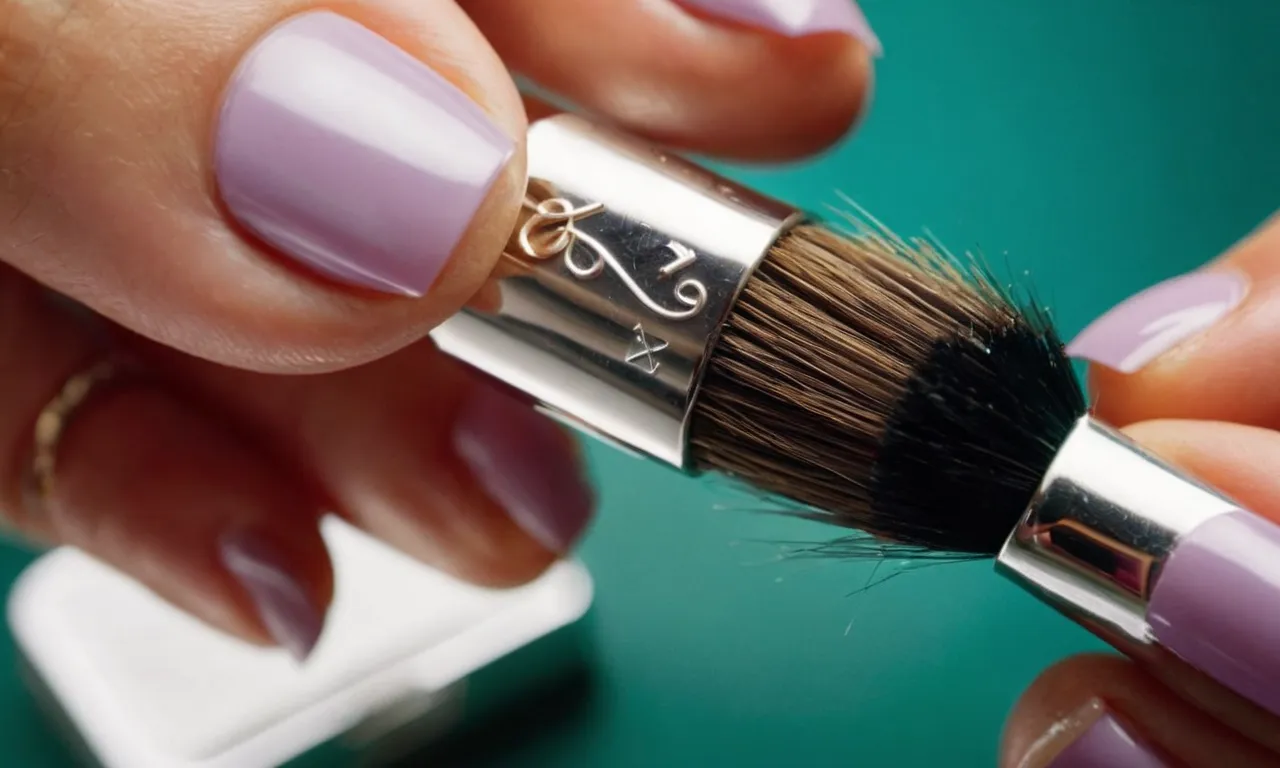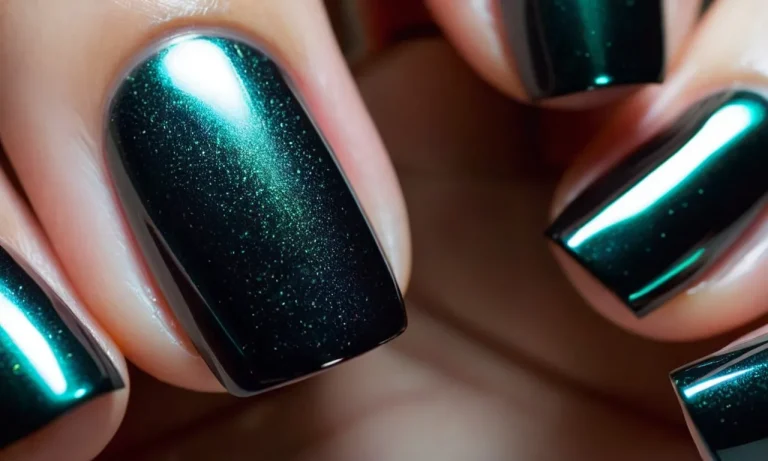What Type Of Hair Is Used In Artificial Nail Brushes?
If you have ever gotten acrylic or gel nails applied at a salon, you have likely seen the small, stiff brushes used to apply product to the natural nails. But have you ever wondered what these unique brushes are made of?
The short answer is that most artificial nail brushes are crafted using nylon or a blend of both nylon and natural hairs.
In this comprehensive guide, we will cover everything you need to know about the materials used to create quality artificial nail brushes. We will explore the most common types of synthetic and natural hairs used, compare the benefits and downsides of each, and provide tips for identifying high-quality nail brushes.
Common Types of Synthetic Filaments
Nylon
Nylon is one of the most common synthetic filaments used in artificial nail brushes. It is a strong, flexible material that is durable and resistant to damage. Nylon bristles have a smooth texture that is gentle on natural nails and allows for easy application of nail products.
Some key benefits of nylon include:
- Strength – Nylon bristles are very strong and do not lose their shape easily, even with repeated use and cleaning.
- Flexibility – The filaments have some bend and give to them, preventing scratching or damage to the natural nail surface.
- Durability – Nylon stands up well to frequent handling, washing, and exposure to nail products without breaking down.
- Versatility – Nylon bristles can be used for many nail art techniques, including applying polish, acrylics, dip powders, and more.
Polyester
Polyester is another synthetic filament that offers stiffness, springiness, and resistance that is advantageous for nail brushes. Compared to nylon, polyester is a bit more rigid and less prone to losing its shape. Key benefits of polyester include:
- Stiffness – Polyester bristles are stiff and spring back readily, which provides good control.
- Heat resistance – The filaments hold up well when exposed to the heat of nail lamps used for curing gel polish.
- Shape retention – Polyester bristles maintain their arrangement and do not get bent out of shape easily.
- Affordability – Polyester is an inexpensive synthetic material, keeping costs down.
The firmness of polyester makes it ideal for nail art brushes intended for fine details or one-stroke paintings. The bristles resist “splaying” and can hold their point nicely. Quality polyester filaments are a smart choice for intermediate to advanced nail artists.
Microfibers
Microfiber filaments are very fine synthetic hairs that create ultra-soft, smooth brushes. They are usually made from a blend of synthetic materials like nylon and polyester. Key traits of microfiber include:
- Softness – The tiny fibers feel extremely soft and gentle on the natural nails.
- Precision – Microfibers allow for precise, detailed artwork due to their fine tips.
- Blending ability – The small fibers pick up and blend pigments easily to create seamless color gradients.
- Stain resistance – Microfiber resists staining from pigments better than natural hairs.
Microfiber nail brushes are a top choice for advanced nail technicians doing intricate designs. The soft, tiny bristles allow jaw-dropping nail art while being gentle on the nails. Salon-quality brush sets often feature microfiber for specialty brushes.
Natural Hair Sources
Sable Hair
Sable hair brushes are made from the fur of sable animals like marten, kolinsky, or fox. This type of hair is appreciated for its strength, elasticity, and ability to hold a fine point for detail work (critical properties for quality nail art brushes).
The finest sable hair used in nail art brushes comes from male kolinsky sable animals found in cold climates like Russia and China. This fur is harvested during winter when the hair follicles produce the thickest, most resilient fur to protect against the cold temperatures.
Kolinsky sable hair is considered the gold standard for nail art brushes given its superior snap and precision for polish control. A single kolinsky sable hair is strong enough to hold a fine tip while having enough flexibility to smoothly drag color along the nail surface.
Statistics show that a quality kolinsky brush can maintain a sharp point through over 1000 strokes before a retouch is required (source).
Pony Hair
Pony hair, often called squirrel hair, is another natural hair valued for its appliction in nail brushes. This silkier hair comes from pony animals residing in the northern-most climates like Siberia. The extreme cold climate helps pony hair hold its shape better while the softer texture allows for smooth polish application.
In testing, pony hair nail brushes are not as durable as sable hair for holding a super fine tip through repeated strokes. However, the softness of pony hair creates beautiful blends when doing transitions or ombre effects on nails.
Many nail techs actually prefer pony hair for bigger nail art brushes used for abstract designs, color blocking, or bold strokes requiring soft edges (the elasticity prevents unwanted hard lines).
Goat Hair
Goat hair is not typically used for professional quality nail art brushes but may be found in cheaper brush sets. While the natural texture helps grab and hold polish well, goat hair does not have the snap and precision of sable or pony hair when used on nails.
The porous structure causes goat hair to fray and lose shape faster. Most nail artists consider brushes with a high percentage of goat hair substandard for detailed manicures or pedicures.
According to industry expert Chloe Nguyen, goat hair brushes still serve a purpose for beginner nail technicians looking to hone technique before investing in luxury sable sets. The affordable cost allows new artists to practice nail strokes and gain experience without worry of ruining expensive sable brushes early on (source).
Once skill progresses, upgrading to sable or pony hair is recommended for professional quality manicures that clients expect.
Nylon vs. Natural Hairs
Durability and Shape Retention
Nylon fibers are known for their durability and ability to hold their shape well. They are resistant to shedding and fraying even after repeated use and cleaning. This makes them a popular choice for artificial nail brushes as they can maintain their stiffness and pointed tips for precise application and sculpting of products like acrylics or gel polishes.
Nylon bristles tend to be thicker than natural hairs which contributes to their stiffness and rigidity. This stiffness allows them to stand up to the friction against nail plates during filing and shaping. Overall, the longevity and shape retention of nylon bristles outperforms natural hairs.
Ability to Hold Product
The ability to hold and retain product is another key factor when selecting fibers for nail brushes. Nylon fibers tend to have a smooth surface which limits their ability to grab and hold onto viscous nail products like acrylic and gel polish.
The products can slide off the bristles rather than sticking to them. Natural fibers like sable or kolinsky hair have microscopic scales and pores that help grab and retain more product. The natural texture of the cuticle on real hair creates more friction to grip product.
Many nail artists prefer the holding power of natural bristles when working with thicker sculpting products or polish applications. However, nylon blends are improving by adding specially textured surfaces to improve retention while maintaining nylon’s shape.
Softness and Flexibility
Softness and flexibility are other considerations when choosing between nylon and natural bristles. Nylon fibers tend to be thicker and stiffer than real hair. While this creates the desired rigidity and shape retention, it can feel scratchy or uncomfortable on the natural nails.
Softer natural hairs like sable have more give and flex which creates a smoother feel on the nails. The tips have more movement and can fan out during polish applications to adapt to the nail curvature.
However, softer hairs lack the precision and control that stiff nylon can provide for detailed acrylic sculpting. Many higher end nail brushes strike a balance by using a blend of both nylon and natural bristles.
This allows brushes to have the precision of nylon with a softer natural feel on the nails.
Tips for Identifying Quality Nail Brushes
Check the Ferrule
The ferrule is the metal band that connects the bristle fibers to the handle of the nail brush. A quality ferrule should be sturdy and well-constructed using nickel or copper materials to prevent corrosion.
The ferrule width should also be proportional to the brush size – generally around 1/4 inch for most nail brush handles.
When examining the ferrule, check that the bristles are securely fastened without falling out. Gently tug on the fibers to verify strong adhesion. Avoid brushes where the ferrules are loose or shallow as this can indicate weak bristle bonding.
Look for Proper Blending
High-end nail brushes use a blend of natural and synthetic bristles for optimal performance. Quality blending involves an even mix of bristle materials interspersed evenly across the brush head.
Natural bristles in nail brushes tend to derive from sable, squirrel, goat, or pony fur. Synthetics may use nylon, polyester, or taklon fibers. Well-blended brushes demonstrate a harmonious combination of both for balanced firmness and softness.
Beware of brushes claiming to be “100% natural.” While natural bristles provide softness, synthetics add durability and prevent premature shedding. Properly blended brushes last longer while retaining pleasant flexibility.
Assess Bristle Softness
Nail brush softness significantly impacts cleaning ability and cuticle/nail bed safety. Bristle tips should feel smooth, round, and gentle against skin surfaces. Overly stiff fibers can damage delicate periocular tissue.
High-end nail brushes strike an optimal balance – firm enough toscrub nails but flexible enough for comfort. Before purchase, gently press bristle tips then stroke skin to test softness. Quality brushes easily contour to surfaces while retaining mild scrubbing friction.
Ivory-White bristle tips also indicate premium softness from top-grain hair selection without vulnerability to damage or splitting.
Caring for Your Artificial Nail Brushes
Clean Properly After Each Use
Keeping your artificial nail brushes clean is crucial for longevity and preventing the spread of bacteria. After each use, wash the bristles thoroughly with warm water and a mild soap or brush cleaner. Gently massage the bristles to remove any residue, avoiding getting water on the base.
Rinse and dry the bristles facing downwards. Disinfect brushes at least once a week by soaking them in 70% isopropyl alcohol for 5-10 minutes. This helps kill germs and bacteria.
Store Bristle-Side Up
Storing artificial nail brushes properly between uses will help maintain their shape and effectiveness. Place brushes bristle-side up on a clean, dry surface or in a jar. Never store wet or damp brushes in sealed containers, as this can breed bacteria and mold.
Storing bristle-side up allows gravity to keep the bristles straight and avoids flattening. Avoid extremes in temperature and humidity. Ideal storage is in a cool, dry place away from heat, moisture, and direct sunlight.
Replace Regularly
With regular use, the bristles on artificial nail brushes will eventually wear out. Replace brushes every 2-3 months for best results. Signs that it’s time for a new brush include: frayed or broken bristles, shedding, diminished brushing capability, and bacteria buildup that can’t be fully removed with cleaning.
Using worn-out brushes won’t properly shape nails and can even damage nail beds. Investing in quality brushes and replacing them regularly ensures a safe, hygienic nail care routine.
Conclusion
While nylon has become the most common filament used in artificial nail brushes, natural hairs like sable and pony can still provide some advantages. It is important to invest in quality brushes, care for them properly, and replace them regularly to achieve the best acrylic and gel nail application results.
We hope this guide has helped shed light on the different materials used in professional nail brushes. Next time you are shopping for new supplies, use these tips to pick out brushes that will work best for your technique and nail services.







